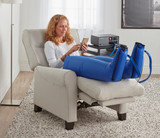Stanford University Study on Lymphedema
Falk Cardiovascular Research Center
Stanford University School of Medicine
300 Pasteur Drive
Stanford, California 94305-5406 - (650) 723 6141
Division of Cardiovascular Medicine
Presented
here are abstracts from a recently completed study by the Stanford
University Center for Lymphatic and Venous Disorders. The study
evaluates the use of Pneumatic Sequential Compression for the treatment
of postmastectomy lymphedema.
The Stanford University Center for
Lymphatic and Venous Disorder is the foremost institution in the
country studying the treatment of lymphedema. Bio Compression pumps were
used exclusively in this study.
AN EVALUATION OF ADJUNCTIVE INTERMITTENT PNEUMATIC COMPRESSION IN THE ACUTE TREATMENT OF POSTMASTECTOMY LYMPHEDEMA
A. Szuba, R. Ashalu, SG Rockson
Stanford Center for Lymphatic and Venous Disorders,
Stanford University School of Medicine, Stanford, CA USA
Srockson@cvmed.stanford.edu
We investigated the safety and efficacy of adjunctive intermittent
pneumatic compression (IPC) for the acute decongestive therapy of
post-mastectomy lymphedema. Twenty-three patients were randomized to
decongestive lymphatic therapy (DLT) with (Group II) or without (Group
I) IPC. DLT included manual lymphatic drainage, bandaging, and exercise,
performed daily. In Group II, 30 minutes of IPC was performed daily at
40-50 mm Hg. Arm volume was assessed by tank volumetry.
In
Group I, the 11 patients achieved 26% acute arm volume reduction; in
Group II, the 12 patients achieved a mean volume reduction of 45.3%
(p,0.05). There were no complications attributable to either DLT or IPC.
Conclusion:, IPC is generally safe and well-tolerated and appears to
provide synergistic benefit when used with DLT in the acute
decompressive approach to post–mastectomy lymphedema.
EVALUATION OF INTERMITTENT PNEUMATIC COMPRESSION AS ADJUNCTIVE MAINTENANCE THERAPY IN POSTMASTECTORMY LYMPHEDEMA
A. Szuba, R. Achalu, S.G. Rockson
Stanford Center for Lymphatic and Venous Disorders,
Stanford Univerity School of Medicine, Stanford, CA USA
Srockson@cvmed.stanford.edu
We studied the safety and efficacy of intermittent pneumatic
compression therapy as an adjunct to standard decongestive lymphatic
therapy in patients with stable post-mastectomy arm lymphedema.
Study design: Randomized, cross-over, 2 month study with 6 month follow-up
Patients and methods: 29 patients with postmastectomy arm lymphedema
and without evidence of active cancer were enrolled. Patients were
randomized into two groups.
Patients assigned to Group I were
asked to continue their routine maintenance therapy with use of a Class
II compression garment and self–applied manual lymphatic drainage (MLD);
patients assigned to Group II were asked to use the intermittent
pneumatic compression (IPC) pump for 1 hour daily (40-50mmHg) in
addition to conventional therapy (garments + MLD). All patients crossed
over to the alternate therapy after one month. Patients who elected to
continue chronic use of the pump were evaluated after 6 months. Clinical
evaluation was performed at the beginning of the study, after the first
and the second month and after six month follow-up. The evaluation
included tank volumetry, skin tonometry, and measurement of range of
motion.
Results: 27 patients completed the study. Two patients voluntarily withdrew.
There
was a mean volume reduction of 89.5 ml during the month with IPC and
volume increase of 32.7 ml during the month of routine maintenance
therapy.
The difference was statistically significant
(p0.05). There was no difference in tonometry results. Of the 21
patients who completed chronic use of IPC, 19 were available for
analysis. After 6 months, there was a further average volume reduction
of 29.1 ml (not statistically significant). No adverse effects of IPC
were observed.
Conclusion: Intermittent pneumatic
compression is safe and well tolerated and may offer additional benefit
for patients with postmastectomy lymphedema.
Recent Posts
-
Lymphedema Sequential Pump Management
Patients living with Lymphedema find the condition can be very difficult at times both physically an …Feb 8th 2019 -
Lymphedema Treatment
Lymphedema is the result of fluid accumulation in a blocked lymph channel causing pain and swellin …Jul 25th 2016 -
Stanford University Study on Lymphedema
Falk Cardiovascular Research Center Stanford University School of Medicine 300 Pasteur Drive Stanfor …Jul 25th 2016
